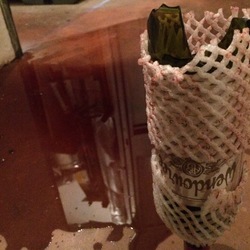Jay Kline 

@rhythmSOULdier
Marie Demets
Harmonie Blanc de Blancs Champagne
Popped and poured; enjoyed over the course of 90 minutes. The Harmonie pours a bright straw color with a persistent mousse. On the nose, the wine is developing with lovely notes of yellow apple, white flowers, star fruit, lemon curd, limestone and chalky minerals. On the palate, the wine is dry with medium+ acid. Confirming the notes from the nose, the finish is medium+. This is a delicious BdB from the Côte de Bar that gives Chablis vibes (if Chablis had bubbles of course). Drink now through 2035. Thanks for the assist @Lyle Fass
Date of Tirage: 07/17/2023
Disgorged 01/22/2025
Dosage: 1g/L
P.S. this is likely the last of the clear glass bottles for Harmonie as they will be moving to dark glass in the future. — 5 days ago
Seavey Vineyard
Estate Grown Cabernet Sauvignon 2006
Poured into a decanter about an hour prior to service; enjoyed over the course of a couple hours. The 2006 pours a deep garnet/purple with a near opaque core; medium+ viscosity with moderate staining of the tears and a decent amount of fine sediment. On the nose, the wine is vinous with heady notes of cassis, black cherry, plums, Kalamata olive, purple flowers, pipe tobacco, leather, earth, and fine baking spices. On the palate, the wine is dry with medium+ tannin and medium+ acid. Confirming the notes from the nose. The finish is long with savory minerals. Absolutely delicious. Drink now, though well-stored examples should drink well through 2036 — a month ago
Colgin Cellars
Herb Lamb Vineyard Cabernet Sauvignon 1993
Popped and poured; enjoyed out of red Solo cups over the course of a few hours. The 1993 “Herb Lamb” pours a deep garnet/purple with an opaque core; medium+ viscosity with moderate staining of the tears and significant sediment. On the nose, the wine is vinous with heady notes of mostly ripe and some desiccate fruit: black currants, blackberries, black plum, a mix of red and purple flowers, tobacco, Poblano pepper, leather, cocoa, some tilled earth and fine baking spices. On the palate, the wine is dry with medium+ tannin and medium+ acid. Confirming the notes from the nose. The finish is long. Delicious. This was an outstanding showing. Drink now through 2033+ — a month ago
Domaine Hubert Lignier
Gevrey-Chambertin Pinot Noir 2014
Popped and poured; enjoyed over the course of an hour. The 2014 Gevrey-Chambertin pours a garnet color with a translucent core; medium viscosity with no staining of the tears. On the nose, the wine is developing with notes of strawberry, raspberry, sous bois, red flowers, horse blanket, mushroom and a mix of cool and warm spices. On the palate, the wine is dry with medium tannin and medium+ acid. Confirming the notes from the nose. The finish is medium+. This is a fairly textbook example of the 2014 vintage with its rustic green streak coupled with Lignier’s charm. Drink now through 2029. — 2 days ago
Domaine Charvin
Châteauneuf-du-Pape Red Rhône Blend 2021
Popped and poured; enjoyed over the course of several hours. The 2021 pours a deep ruby color with a translucent core; medium+ viscosity with no staining of the tears. On the nose, the wine is developing with fabulous, bright notes of Bing cherry, strawberry, star anis, red flowers, black pepper, cool spices, and stoney earth. On the palate, the wine is dry with medium tannin and medium+ acid. Confirming the notes from the nose. The finish is medium+. This is a beautiful example from one of the more Burgundian producers in CdP, making wine in a very Burgundian vintage. Lovely stuff. Drink now through 2036. Bottle No. 28340 — 5 days ago
Fattoria la Ripa
Santa Brigida Vin Santo Chianti Classico Sangiovese Blend 2001
Enjoyed a single glass after a lovely dinner. The 2001 appears a deep amber color with medium viscosity. On the nose, the wine is vinous with notes of apricot marmalade, candied nuts, burnt molasses, espresso, and a mix of cool and warm spices. On the palate, the wine is dry with medium+ acid. Confirming the notes from the nose. The finish is long and bitter but ever so lovely. Could a wine like this live forever? One of those questions that keeps me up at night. — a month ago

Diego Conterno
Barolo Nebbiolo 2020
Popped and poured; enjoyed over the course of a couple hours. The 2020 pours a deep garnet color with a translucent core; medium+ viscosity with no staining of the tears. On the nose, the wine is developing with notes of ripe and tart fruits: Morello cherry, raspberry, cranberry, roses, tar, cool spices and dry earth. On the palate, the wine is dry with high tannin and medium+ acid. Confirming the notes from the nose. The finish is medium+. I found this bottle to be a little shy for the first 30min or so but opened up nicely by the end of our meal. Drink now through 2040. — 2 days ago
Cavallotto
Bricco Boschis Barolo Nebbiolo 2021
A continuation of sharing my early impressions of the 2021 vintage in Barolo; Cavallotto is one of those benchmark producers for me, inextricably connected to Bricco Boschis, which they have farmed for nearly 100 years. Popped and poured; enjoyed over the course of a few hours. The 2021 Bricco Boschis pours a brilliant garnet color with a transparent core; medium+ viscosity with no staining of the tears. On the nose, the wine is developing with powerful notes of Morello cherry, dehydrated orange, cumin, tar, roses, talcum powder, fresh sage and fresh mint, and dried gravelly earth. On the palate, the wine is bone dry with structure like that of Helm’s Deep; the tannins are absolutely rippin’ and acid at medium+. Confirming the notes from the nose. The finish is extremely long, savory and drying, to the point that you feel it in your gums several minutes. A brilliant Barolo that has a very long life ahead. Drink now with plenty of air and patience through 2071. Pairs well with hearty lasagna and baseball. — a month ago
Azienda Agricola Renato Molino
Barolo Nebbiolo 2019
Popped and poured; enjoyed over the course of two days. Consistent both days but this needed at least 3 to 4 hours to really start to strut. Day 2 this kept pulling like a freight train with no stop in sight. The 2019 Classico pours a garnet color with a slightly orange tinge and a transparent core; medium+ viscosity with no staining of the tears. On the nose, the wine is developing with powerful notes of ripe Morello cherry, roses, tar, new leather, dried sage, old wood and dry gravelly earth. On the palate, the wine is bone dry with high tannin and medium+ acid. Confirming the notes from the nose. The finish is long. I will say again, this really benefits from serious patience and air, but this is a beautiful Classico that has a very long life ahead. Drink now through 2059+. — a month ago


Jay Kline

Popped and poured; enjoyed over the course of an hour. The 2020 “Les Enseignères” pours a luminous, light straw color with medium viscosity. On the nose, the wine is developing with bright notes of apple, starfruit, lemon, a touch of almond, and limestone minerals. On the palate, the wine is dry with medium+ acid. Confirming the notes from the nose. The finish is medium plus. Quite tasty in its relative youth. Drink now through 2035.  — 2 days ago